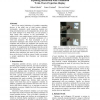Free Online Productivity Tools
i2Speak
i2Symbol
i2OCR
iTex2Img
iWeb2Print
iWeb2Shot
i2Type
iPdf2Split
iPdf2Merge
i2Bopomofo
i2Arabic
i2Style
i2Image
i2PDF
iLatex2Rtf
Sci2ools
ISWC
2005
IEEE
2005
IEEE
Exploring Interaction with a Simulated Wrist-Worn Projection Display
One of the major limitations of portable computing devices is the small size of their built-in displays. Fortunately, extremely small projection systems are being developed that can be integrated into devices that are small enough to be body-worn, yet can project a large image onto surfaces in the environment. To explore how a user might interact with this near-horizon technology, we created a functional simulation of a wrist-worn projector. We then developed a set of interaction techniques that assume that the wrist-worn computer and projector are equipped with position and orientation sensors, in addition to a touch-sensitive builtin screen. To complement the techniques that rely on the spatial manipulation of the user’s forearm and the device itself, we also describe the use of a cursorless watch user interface that minimizes the need for the user to look down at the device’s built-in screen. Finally, we present a sample application that illustrates our interaction techniques.
| Added | 25 Jun 2010 |
| Updated | 25 Jun 2010 |
| Type | Conference |
| Year | 2005 |
| Where | ISWC |
| Authors | Gábor Blaskó, Steven Feiner, Franz Coriand |
Comments (0)

